Enjoy the diverse and ever changing allure of the Namibian landscape during this lodge safari. Beginning in Wondhoek, this safari takes you through the deserts of the Namib-Naukluft National Park to the coastal town of Swakopmund. Travel along the coast to visit the Cape Fur Seal breeding grounds at Cape Cross before heading inland, stopping at the majestic Petrified Forest. Spend three days with Africa’s famous Big 5 in Etosha National Park; visit Waterberg on your return journey to Windhoek.
Departs: Windhoek, Namibia.
Ends: Windhoek, Namibia.
Group size: Guaranteed from 4 guests; 12 guests maximum. *Guaranteed departures with no minimum pax available, please enquire.
Summary
A small-group lodge safari from / to Windhoek through Namibia.
Highlights
Windhoek, Sossusvlei, Swakopmund, Damaraland, Cape Cross Seal Colony, Twyfelfontein, Petrified Forest, Game Drives in Etosha National Park, Visit to the Cheetah Conservation Foundation & Waterberg Plateau National Park.
Meals
10x Breakfast, 8x Lunch. Breakfast is included daily and provided by the lodge restaurants. A dinner package is available, at additional cost for 6 dinners. This needs to be booked in advance and the meals are to be taken in the lodge restaurants. Please advise us of any special dietary requirements in advance. Should you not wish to pre-pay for this, dinners will be for your own account and will still need to be taken in local restaurants or at the lodges if there are no restaurants in the nearby vicinity. There are no facilities available for self-catering.
SAFARI
COST: Call for Pricing.
SINGLE SUPPLEMENT: Call for Pricing. |
|
|
DAY 1; (1 Night)
WINDHOEK, Namibia [Guest House] |
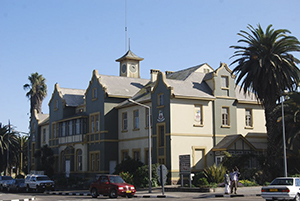 On arrival at Hosea Kutako International Airport in Namibia’s capital, Windhoek, you will be met and transferred to your accommodation for the night. Your guide will meet you at the lodge and we then embark on a short orientation city tour of Windhoek. The evening is spent at leisure. On arrival at Hosea Kutako International Airport in Namibia’s capital, Windhoek, you will be met and transferred to your accommodation for the night. Your guide will meet you at the lodge and we then embark on a short orientation city tour of Windhoek. The evening is spent at leisure.
|
Overnight: Klein Windhoek Guesthouse or similar (rooms with en-suite bathrooms, swimming pool, bar & restaurant).
Meals: All meals at your own account.
|
DAYS 2 - 3; (2 Nights)
WINDHOEK - SOSSUSVLEI, Namibia [Chalets] |
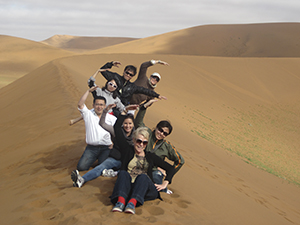 Today we make our way to the Namib Naukluft National Park, which contains what is considered to be the oldest desert in the world. The next morning we need to wake up early to visit the world’s highest sand dunes at Sossusvlei and Deadvlei. These dunes, which can reach heights of over 300 m, are absolutely spectacular and provide for a fantastic photo opportunity. With luck, there may even be water in the vlei (lake). We also stop to view the Sesriem Canyon, which was carved millions of years ago by the Tsauchab River. Today we make our way to the Namib Naukluft National Park, which contains what is considered to be the oldest desert in the world. The next morning we need to wake up early to visit the world’s highest sand dunes at Sossusvlei and Deadvlei. These dunes, which can reach heights of over 300 m, are absolutely spectacular and provide for a fantastic photo opportunity. With luck, there may even be water in the vlei (lake). We also stop to view the Sesriem Canyon, which was carved millions of years ago by the Tsauchab River.
|
Departure Day 2: 8am
Distance Day 2: 285 kms
Departure Day 3: 5am
Distance Day 3: 245 kms
Overnights Day 2 & 3: Agama River Camp or similar (rooms with en-suite bathrooms, swimming pool, sunset deck & bar / restaurant area).
Meals Day 2: Breakfast at Klein Windhoek Guesthouse or similar; Lunch prepared by the guide; Dinner for your own account.
Meals Day 3: Breakfast packs from Agama River Camp or similar; Lunch prepared by the guide; Dinner for your own account.
|
DAY 4 - 5; (2 Nights)
SOSSUSVLEI - SWAKOPMUND, Namibia [Chalets] |
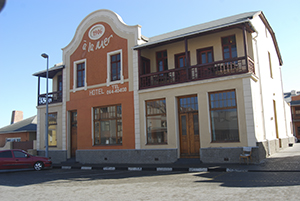 Day 4 is spent driving through the Namib Naukluft National Park on our way to Swakopmund. The Namib-Naukluft Desert is an ancient land with an ageless spirit. It is home to some of the rarest plant and animal species in the world. Sightings of these unique fauna and flora are a must on a Namibian safari. The animals of this harsh landscape include the oryx, springbok and Hartmann’s Mountain Zebra. Day 4 is spent driving through the Namib Naukluft National Park on our way to Swakopmund. The Namib-Naukluft Desert is an ancient land with an ageless spirit. It is home to some of the rarest plant and animal species in the world. Sightings of these unique fauna and flora are a must on a Namibian safari. The animals of this harsh landscape include the oryx, springbok and Hartmann’s Mountain Zebra.
We arrive at the charming coastal town of Swakopmund in the afternoon, where you will have the opportunity to partake in a few of the many optional activities this afternoon and the following day. Alternatively, just soak up the atmosphere of this quaint, little German town and enjoy its beauty and beaches. |
Departure: 8am
Distance: 300 kms
Overnight: Hotel A La Mer or similar (standard rooms with en-suite bathrooms).
Meals Day 4: Breakfast at Agama River Camp, Lunch prepared by guide, Dinner for your own account.
Meals Day 5: Breakfast at Hotel A La Mer or similar, Lunch for your own account, Dinner for your own account.
Optional Activities (at extra cost which is subject to change): Quad biking (2 hour) R600, Sand boarding lie-down R400, Sand boarding standing up R500, Living Desert Tour R700, Tandem Sky Diving R2100, Shore fishing R1500 Boat fishing R1350, Township Tour R450, Kayaking R650, Dolphin-Seal-Whale Cruise R600.
|
DAY 6; (1 Night)
SWAKOPMUND TO CAPE CROSS SEAL COLONY, TWYFELFONTEIN & PETRIFIED FOREST, Namibia [Lodge] |
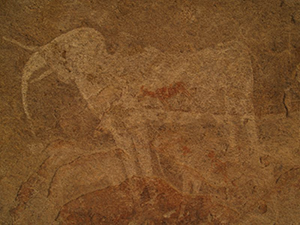 We travel along the barren Atlantic coast on our way out of Swakopmund to visit Cape Cross - the largest breeding site of the Cape Fur Seal. Leaving the coastline behind, we head inland across the desert plains for Twyfelfontein and view the ancient Bushmen paintings and engravings. Twyfelfontein was named a World Heritage site in 2007, the first Namibian location to receive this honour. The next morning we make a stop at the Petrified Forest, the trees of which are estimated to be 250 million years old. We travel along the barren Atlantic coast on our way out of Swakopmund to visit Cape Cross - the largest breeding site of the Cape Fur Seal. Leaving the coastline behind, we head inland across the desert plains for Twyfelfontein and view the ancient Bushmen paintings and engravings. Twyfelfontein was named a World Heritage site in 2007, the first Namibian location to receive this honour. The next morning we make a stop at the Petrified Forest, the trees of which are estimated to be 250 million years old.
|
Departure: 8am
Distance / Time: 430 kms
Overnight: Twyfelfontein Country Lodge or similar (rooms with en-suite bathrooms, restaurant and swimming pool).
Meals: Breakfast at Hotel A La Mer or similar, Lunch prepared by guide, Dinner for your own account. |
DAYS 7 - 8; (2 Nights)
ETOSHA NATIONAL PARK, Namibia [Lodge] |
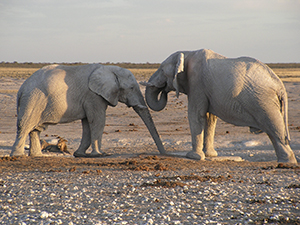 Today we travel to Namibia’s best-known highlight of the north – Etosha National Park. We will fill the next 2 days with game drives in the hopes of spotting lion, leopard, elephant and rhino as well as cheetah, giraffe, zebra and the numerous different types of antelope the park has to offer. Etosha was declared a National Park in 1907 and it is home to approx. 114 mammal species, 340 bird species, 110 reptile species, 16 amphibian species and, surprisingly, one species of fish. Today we travel to Namibia’s best-known highlight of the north – Etosha National Park. We will fill the next 2 days with game drives in the hopes of spotting lion, leopard, elephant and rhino as well as cheetah, giraffe, zebra and the numerous different types of antelope the park has to offer. Etosha was declared a National Park in 1907 and it is home to approx. 114 mammal species, 340 bird species, 110 reptile species, 16 amphibian species and, surprisingly, one species of fish.
|
Departure Day 7: 8am
Distance Day 7: 250 kms
Departure Day 8: 8am
Distance Day 8: 350 kms
Overnights Day 7 & 8: Toshari Lodge or similar (rooms with en-suite bathrooms, swimming pool, bar & restaurant).
Meals Day 7: Breakfast at Twyfelfontein Country Lodge or similar; Lunch prepared by the guide; Dinner for your own account.
Meals Day 8: Breakfast at Toshari Lodge or similar; Lunch prepared by the guide; Dinner for your own account. |
DAY 9; (1 Night)
ETOSHA NATIONAL PARK - WATERBERG PLATEAU PARK, Namibia [Chalets] |
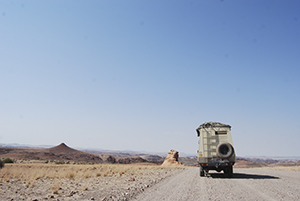 This morning we bid farewell to the wild animals of Etosha and travel via the Cheetah Conservation Foundation at Otjiwarongo to the Waterberg Plateau National Park. The CCF is an internationally recognised centre for research and education on cheetahs and their eco-systems. It boasts an extensive visitor’s centre, which encourages tourists to learn more about these beautiful cats and the efforts being made to save them. The Waterberg is a sandstone plateau which rises over 200 m from the surrounding plains and gives name to Namibia’s only mountain game park. Waterberg now supplies other Namibian parks with rare species. In 1989, black rhino were reintroduced to the area from Damaraland, sparking a successful breeding programme of national and international significance for the species. There are various trails to walk along searching for the elusive Damara dik-dik as well as a good variety of birds. This morning we bid farewell to the wild animals of Etosha and travel via the Cheetah Conservation Foundation at Otjiwarongo to the Waterberg Plateau National Park. The CCF is an internationally recognised centre for research and education on cheetahs and their eco-systems. It boasts an extensive visitor’s centre, which encourages tourists to learn more about these beautiful cats and the efforts being made to save them. The Waterberg is a sandstone plateau which rises over 200 m from the surrounding plains and gives name to Namibia’s only mountain game park. Waterberg now supplies other Namibian parks with rare species. In 1989, black rhino were reintroduced to the area from Damaraland, sparking a successful breeding programme of national and international significance for the species. There are various trails to walk along searching for the elusive Damara dik-dik as well as a good variety of birds.
|
Departure: 7am
Distance: 320 kms
Overnight: Waterberg Camp or similar (rooms with en-suite bathrooms, swimming pool, shop, bar & restaurant).
Meals: Breakfast at Toshari Lodge or similar, Lunch prepared by guide, Dinner for your own account. |
DAY 10; (1 Night)
RETURN TO WINDHOEK, Namibia [Guest House] |
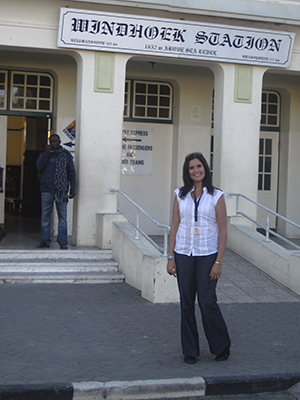 We leave the Waterberg Plateau behind us and travel back to Windhoek through the beautiful countryside, making short stops en-route. Once we arrive, the rest of the afternoon can be spent at leisure, and dinner can be enjoyed in one of the many fabulous restaurants in the city. We leave the Waterberg Plateau behind us and travel back to Windhoek through the beautiful countryside, making short stops en-route. Once we arrive, the rest of the afternoon can be spent at leisure, and dinner can be enjoyed in one of the many fabulous restaurants in the city.
|
Departure: 8am
Distance / Time: 290 kms
Overnight: Klein Windhoek Guesthouse or similar (rooms with en-suite bathrooms, swimming pool, bar & restaurant).
Meals: Breakfast at Waterberg Camp or similar, Lunch prepared by guide, Dinner for your own account. |
DAY 11
WINDHOEK, Namibia [TOUR ENDS] |
Our safari ends after breakfast. You will be transferred to Windhoek Airport in time for your departure flight. We hope to welcome you again one day on another of our African adventures. |
Meals: Breakfast at Klein Windhoek Guesthouse or similar.
|
Note: The accommodation specified in the itinerary is a guide only and is subject to availability. Alternatives will be nearby and of a similar standard.
 Top Top
Included
Accommodation as mentioned in the itinerary, transport in fully kitted, 12 seater 4x4 safari vehicle or similar, game drives and activities as mentioned, meals as per itinerary, park entrance fees, experienced local guide.
Excluded
Travel insurance, flights, pre and post tour accommodation, optional activities, all drinks, tips and curios, all personal expenses.
Departure
The Namibia Lodge Safari departs from Klein Windhoek Guesthouse in Windhoek.
Please note that the daily departure times are a guideline only and are subject to change due to seasonal variations, as well as unforeseen circumstances. The final decision rests with your guide who will advise you at what time you will be departing each day.
On the evening of day 1, there will be a meeting presented by your guide, at 6 pm, at your lodge. It is imperative that all clients attend this meeting so as not to miss out on any critical information. Whilst it is our every intention to adhere to the above mentioned itinerary, there may on occasion be a necessity to make alterations in order to make the tour more enjoyable or practical. Therefore please treat the itinerary as a guide only.
Transport
Fully equipped Toyota Land Cruisers, 12-seater 4x4 safari vehicles or other appropriate vehicles with comfortable seating, large windows for game viewing, a music and PA system and air-conditioning. All luggage, besides hand luggage and photo equipment, is carried on the vehicle or trailer roof racks to ensure maximum comfort in the vehicle.
Travelling Times and Distances
All travelling times are affected by road conditions, border crossings, detours and weather conditions, therefore on certain days travelling times may be longer than anticipated especially where there is a lot of distance to be covered. Please keep in mind that the time it takes to travel 100 km in your home country is not equivalent to the time it takes to travel 100 km on African roads, therefore we encourage you to sit back and enjoy the spectacular scenery Africa has to offer. Where possible additional stops will be made to ensure your travelling comfort at all times.
Accommodation
We make use of mid-range typical African standard lodge accommodation. Accommodation is situated either in national parks, on the banks of a river, or in other places of interest. The accommodation will be a mix of lodges, chalets and tented camps with en-suite bathrooms.
Visas
The onus is on the client to organize all visas required for clients to visit Namibia prior to departure.
Information on Areas Visited
NAMIBIA
'Namibia' means 'open plains' in the ancient Hottentots language. It is a sought after
tourist destination defined by endless sunshine, scenic beauty and unusual and
contrasting topography. Namibia is sandwiched between two deserts - the Namib
Desert, said to be the oldest in the world, on its western coastline and the Kalahari Desert
in the eastern interior. Northern Namibia features the great Etosha National Park, with the
countries largest concentration of game and in the south the majestic Fish River Canyon
plunges 550 m and extends for 160 km. Between these four highlights lies over 820 000
km2 (the size of France & Britain combined) of contrasting scenery.
The world's highest dunes are found in haunting scenery inspiring somber reflection. Prehistoric
rock art, the ancient fossil plant, Welwitschia mirabilis and fossilized dinosaur footprints are preserved in the ancient, rocky mountain ranges.
Many of the features of this country are of particular scientific interest and attract
scientists from all over the world.
Namibia is the first country in the world to include protection of the environment and
sustainable utilization of wildlife in its constitution. About 15,5% of the country has been
set-aside as national parks. In these areas, rare and endangered species of animals, birds and plant life are preserved and protected. They serve as a living reminder to us all, and to the generations of the future, of how it once was in Africa.
Etosha National Park
Consisting of over 22 000 km2 of saline desert, savannah and woodlands, the Etosha National Park is one of the largest game reserves in Africa and one of the major sanctuaries for wildlife. Its definitive feature is the Etosha Pan, a vast shallow depression of about 5 000 km2. This great, white expanse locals call 'great place of dry water', often shimmers with mirages and herds of game can be seen within this eerie setting.
There are 144 mammal species in the park, including elephant, giraffe, blue wildebeest and black rhino, predators such as lion, cheetah, leopard, wildcat, hyena and jackal.
The black rhino population of 300 is one of the few growing populations in the world and the local elephant are reputed to be the largest in Africa - the tallest standing at 4 m at the shoulder. Their tusks however are relatively small due to genetic defects and mineral deficiencies in their diet.
The majestic eland, the tiny, shy Damara dik-dik (45 cm high) and the striking gemsbok, with its dramatic black and white markings are common. Bird life is prolific and some 340 species have been identified, including Namibia's national bird, the vividly coloured crimson-breasted shrike. During the more rainy seasons Etosha is also one of the most important breeding grounds for flamingos. Etosha is also known for its expert game management and attentive protection of the unspoiled environment.
Damaraland
North of the main road of Swakopmund and South of Kaokoland extends Damaraland,
one of the most beautiful regions in Namibia. Open plains, grasslands, and distant
mountains as well as a petrified forest of 260-millionn year old trees create the
landscape. Damaraland habits Namibia's highest mountain, the Brandberg with its
famous "white lady" painting and the most precious open-air rock art gallery in the world
at Twyfelfontein. Game, which can be found in this area, is the desert elephant, black
rhino, ostrich and springbok.
Swakopmund
A true oasis and respite from the solemn desert and its monotonous heat. A seaside
holiday resort full of old-world charm and modern amenities, from the quaint German
colonial influences to funky Internet café's. The tranquil setting includes promenades,
palm trees and beautifully tended public gardens, the Swakopmund museum (covering
natural history, mineralogy, botany, historical and ethnological aspects), the National
Marine & Research Center, an aquarium, a public library, an Olympic sized, heated
indoor swimming pool and a grassed golf course in a desert setting. This 'middle of the
desert' feel is one of its attractions – one can enjoy the wild expanse of the adjacent
desert and sea and yet be within easy reach of the creature comforts of Swakopmund's
hotels, restaurants, bars and a much-needed laundries!
There is plenty to see and do and activities include quad biking, sand boarding, rock& surf fishing and skydiving. There is also a tannery, manufacturing well-known kudu leather
shoes, a brewery producing fine beers in the German tradition.
Sossusvlei
The visual spectacular in the Sossusvlei area is unsurpassed. Amongst the continuous
towering dunes as far as the eye can see is arguably the highlight of the Namib Desert,
the Sossusvlei, an enormous clay-pan, enclosed by dunes. After a heavy rainfall, rare in
this area, the vlei fills with water and, as the clay layers are virtually impermeable to
water, a turquoise lake remains for quite some time.
The dunes and their rich tints vary from pale apricot to vivid reds and oranges, and
contrast vividly with the dazzling white surfaces of the white clay pans, or lakes, below.
During the rainy season one of the larger of these pans creates a haven for water birds,
often including flamingos. Even during the dry season, Oryx, springbok and ostriches can
be seen feeding off the sparse vegetation along the watercourses.
The dunes of the Namib Desert developed over a period of many millions of years and
are shaped by strong-multi-directional winds. It is thought that the vast quantities of sand
were carried into the Atlantic Ocean by the Orange River. The surf pushed the sandback onto land and coastal dunes formed. Dunes have subsequently shifted inland and
northwards. Wind continuously re-stacks the sand of the huge shifting dunes of the Namib
Desert. It tirelessly forces the grains of sand on the flat windward slope upwards to the
crest of the dune. Here they fall down in the wind shade. The leeward slope, therefore, is
always considerably steeper than the windward side.
Waterberg Plateau Park
The Waterberg Plateau Park can be found 280 km north of Windhoek and stands out from the thorn savannah with its lush vegetation at the lower slopes. This 20 km wide and 50 km long table mountain massif consists of porous sandstone which absorbs surface water which runs off on the southeast side of the plateau as springs, from which it got its name.
Historians may already have heard the name Waterberg. It was the area where in 1904 the devastating battle between the Herero’s and the German Colonial soldiers took place. The only reminder of this tragic event is a military graveyard near the entrance of the park.
Nowadays the Waterberg Plateau is a sanctuary for many endangered species. It hosts among others black and white rhinos, buffalos, various types of antelopes, giraffes, leopards, cheetahs, hyenas, jackals, wild dogs and the only breeding colony of Cape Vulture in Namibia. Beside the big mammals several enchanting small ones can be seen as well, such as the Damara dik-dik or lesser bush babies. The plateau is said to be one of the most interesting geological sites in Namibia and disposes over a rich variety of flowers, trees and shrubs. You can encounter karees, lead wood and buffalo-thorn trees and weeping wattle with its yellow flowers appearing in the spring. Other attractions are the dinosaur tracks and petrified dunes. Unfortunately visitors are not allowed to explore the park in their own vehicles, but there are regular daily excursions organized by the park. The nights can be spent in a beautiful rest camp, which can accommodate more than 200 people, or at a camping site.
Windhoek
Windhoek is the capital and largest city of the Republic of Namibia. It is located in the Khomas Region, has a population of approx. 230,000 and is a major trade centre of sheep skin. It sits on a sloping plain on the northern side of the Khomas Hochland (Khomas Highlands) at an altitude of 1665 metres. Windhoek was originally inhabited by the Herero, then became the centre of a Nama chief who defeated the Herero in the 19th century. Germany occupied the region in 1885, and the city became the seat of colonial rule in 1892 as the capital of the colony of German South-West Africa (Deutsch-Südwestafrika). During World War I Windhoek was captured by South African troops and became a South African Mandate under the League of Nations. Until the independence of Namibia was inaugurated in 1990, Windhoek was recognised as the capital city of South West Africa as administered by the South African government. It continues today as the capital city of the Republic of Namibia.
 Top Top  Return to Budget Safari Packages Return to Budget Safari Packages
|